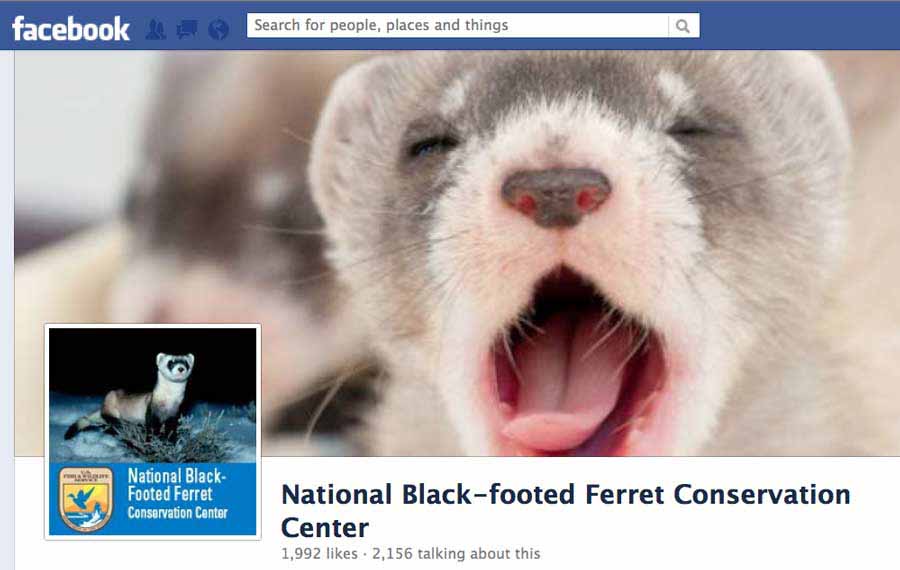
By Ruffin Prevost
CODY, WYO. — Looking to harness to the natural synergy between cute baby animals and the Internet, federal wildlife managers are hoping to make social media stars out of young black-footed ferrets, animals once thought to be extinct before about 130 were found on a Wyoming ranch east of Yellowstone National Park.
The National Black-footed Ferret Recovery Program, a multi-partner project lead by the U.S. Fish and Wildlife Service, has created a Facebook page that allows fans to follow the progress of newborn ferret kits.
“We’re trying to use social media in a way that creates more awareness for one of America’s most elusive, yet charismatic species,” said Kimberly Tamkun of the National Black-footed Ferret Conservation Center.
“We know that if the American public learns more about this species, they’ll be much more likely to support its recovery and, just as importantly, the conservation of many other prairie species who share this rare habitat,” she said.
Twice declared extinct, black-footed ferrets might owe their continuing existence to a ranch dog named Shep.
Meeteetse, Wyo. rancher John Hogg said his wife “happened to hear a commotion with the dog in the middle of the night,” recalling in a 2006 interview a fateful October night in 1981. “The next morning, I went out, and here was this thing lying there, dead.”
Thinking it was perhaps a mink, Hogg grabbed the lifeless ferret from where it lay, next to Shep’s food bowl, and tossed it into a patch of weeds along the Greybull River.
“But (wife) Lucille wanted to have it mounted, so I went back and got it, and we took it to the taxidermist,” Hogg said.
“‘Oh my god, you’ve got a ferret,’ ” Hogg recalled taxidermist Larry LaFrenchie exclaiming. “I said. ‘What the hell is that?’ I hadn’t heard of black-footed ferrets before.”
Neither had most of the rest of the country, with the animal going unseen since the mid-1970s and feared extinct. But Shep’s discovery would soon touch off a firestorm of interest in ferrets that today includes a Facebook page with nearly 2,000 fans who have been following the growth and development of kits in a Colorado captive breeding program.
Recovery efforts began with only 18 ferrets, but more than 7,100 ferrets have since been born in captivity, with approximately 3,000 reintroduced to their native prairie habitat. Approximately 1,000 black-footed ferrets now live in the wild.
Efforts are complicated by the strictly carnivorous ferret’s total dependence on prairie dogs for food.
Loss of habitat and waves of flea-borne sylvatic plague have wiped out prairie dogs across the West, and ferrets remain highly susceptible to canine distemper and the plague.
Federal wildlife managers are hoping Internet-age tools like social media campaigns and YouTube videos will help endear black-footed ferrets to a wider public that appreciates the “masked bandit of the prairie” for its odd dance moves and eccentric personality.
The ultimate goal is to return a needed predator to key Western habitats that lack balance in its absence, but working with charming ferrets can be a fun job on its own.
“It’s a really rewarding project,” Tamkun said.
Contact Ruffin Prevost at 307-213-9818 or [email protected].

As one of the last two people to see a Blackfooted Ferret in the wild before the biologists descended on them and started a turf war west of Meeteetse, all I can say is I hope no other endangered species are ever found in Wyoming —ever — if it means Wyoming Game and Fish becomes the lead agency in their rescue and recovery.
I don’t know about turf wars and there are always two sides to a story. I do know that I am very happy that the Black Footed Ferret is making a comeback and that the Fish and Game Dept has had a major role in returning the ferret to the wild. That is good, in my opinion. Every success story starts with small gains, and returning a species to the wild, one animal at a time, is critical. Am so happy it is happening to this species.